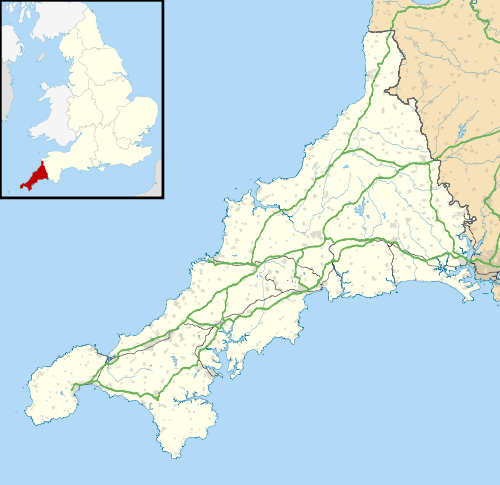St Ewe
| St Ewe | |
| Cornish: Lannewa | |
 St Ewe |
|
| Population | 461 (2011 census) |
|---|---|
| OS grid reference | SW978461 |
| Civil parish | St Ewe |
| Unitary authority | Cornwall |
| Ceremonial county | Cornwall |
| Region | South West |
| Country | England |
| Sovereign state | United Kingdom |
| Post town | ST AUSTELL |
| Postcode district | PL26 |
| Dialling code | 01726 |
| Police | Devon and Cornwall |
| Fire | Cornwall |
| Ambulance | South Western |
| EU Parliament | South West England |
| UK Parliament | St Austell and Newquay |
Coordinates: 50°16′48″N 4°50′20″W / 50.280°N 4.839°W

St Ewe (Cornish: Lannewa) is a civil parish and village in mid-Cornwall, England, United Kingdom. The village is situated approximately five miles (8 km) southwest of St Austell.[1]
Antiquities
Evidence of early medieval habitation is in the form of a roadside Celtic cross that once stood near Nunnery Hill (Charles Henderson in 1925 refers to it being at Lanhadron). However, the crosshead and shaft were thrown down in 1873 by a farmer looking for buried treasure, and both pieces were afterwards lost. The base has survived in situ with an inscription in insular script, unreadable except for the word crucem; Elisabeth Okasha dates the construction of this monument between the ninth and eleventh centuries.[2]
Churches
The parish church is dedicated to St Ewe, a female saint of whom very little is known.[3] The church was originally a Norman cruciform building: the tower and spire were added in the 14th century and the south aisle in the 15th. There is a Norman font and a fine 15th-century rood screen.[4] The small manor of Lanewa was for a long time linked to the advowson of the church; it was probably the secular successor to a Celtic monastery..[5]
At Tucoyse was a Wesleyan Methodist chapel, and there were formerly Bible Christian chapels at Polmassick, Paramore, Kestle and Lower Sticker.[6]
Heligan
The Heligan estate is located at the eastern edge of the parish of St Ewe, overlooking the small port of Mevagissey. The long-term home of the Tremayne family, the estate is now best known as the location of the Lost Gardens of Heligan, a recently restored Victorian garden.[7]
Language
St Ewe was surveyed for the Survey of English Dialects.
Notes
- ↑ Ordnance Survey: Landranger map sheet 204 Truro & Falmouth ISBN 978-0-319-23149-4
- ↑ See the discussion and bibliography in Elisabeth Okasha, Corpus of early Christian inscribed stones of South-west Britain (Leicester: University Press, 1993), pp. 129-132
- ↑ Doble, G. H. (1970) The Saints of Cornwall: part 5. Truro: Dean and Chapter; pp. 30-32
- ↑ Cornish Church Guide (1925) Truro: Blackford; p. 94
- ↑ Cornish Church Guide (1925) Truro: Blackford; p. 94
- ↑ "St Ewe; church history". GenUKI. Retrieved 1 December 2012.
- ↑ Smit, Tim (1999). The Lost Gardens of Heligan. Victor Gollancz. ISBN 0-575-06765-9.
External links
The St Ewe Parish Website: http://st-ewe-parish.co.uk
| Wikimedia Commons has media related to St Ewe. |